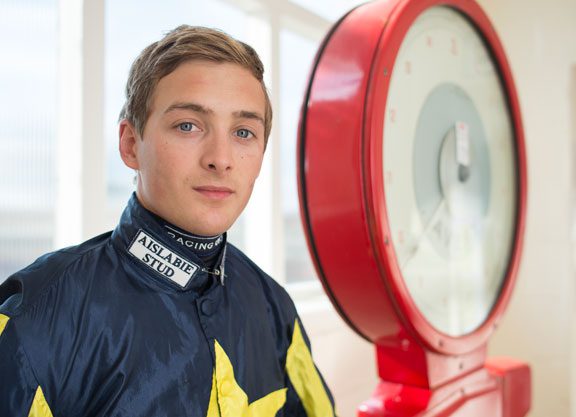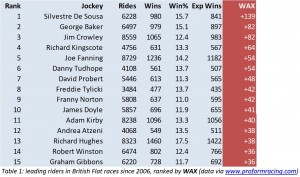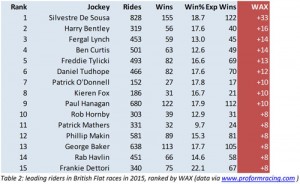Notice: Trying to access array offset on value of type null in /var/www/vhosts/dev.thoroughbreddailynews.com/wp-content/plugins/pmadv-insert-ads/pmadv-insert-ads.php on line 33
The news that jockey Harry Bentley has broken his foot (click here) in a stalls accident in Qatar is a serious blow to his hopes of winning a third domestic riding title there. But the injury should not derail a highly promising career on the global stage.
In 2015, 23-year-old Bentley showed himself a highly undervalued rider in Britain, scoring heavily in a statistical measure that has screamed for years that Silvestre De Sousa is an exceptional talent.
De Sousa–now sufficiently recognized as a superstar to be invited to the International Jockeys' Championship in Hong Kong next month–became champion in Britain this year for the first time, winning the title immediately after losing his job with Sheikh Mohammed's Godolphin operation.
Bentley, too, has had to suffer demotion from a leading position. In 2014, he left the job as second rider to Sheikh Fahad's Qatar Racing operation after two years which, in fairness, probably didn't work out too well for either party. These things happen without reflecting poorly on anyone, and, in May, Bentley signed a contract to ride for Sheikh Fahad's uncle, Sheikh Mohammed bin Khalifa Al Thani, whose blue-and-white colours have been carried by the likes of G1 Poule d'Essai des Pouliches winner Flotilla.
All riders are heavily dependent on the quality of their mounts. As a result, there is a positive feedback effect in which those jockeys with the best mounts regularly find themselves in the winner's enclosure, strengthening the conviction they own superior riding talent. Even the wisdom of the betting crowd regularly fails to decode the signal of talent from the noise, leaving some riders underrated for many years–or even an entire career.
To determine the true talent of a jockey is not straightforward, but to assess whether they are underrated is easy. After a rider has taken a few hundred rides, his total of winners can be compared with that predicted by the starting price of his mounts on the betting exchange, Betfair. If the effect of a rider is appropriately discounted by the betting market, his total of winners will tend towards the aggregate of the implied win probability of his mounts.
For instance, if a rider partnered 1,000 horses who all happened to start at 4-1 odds, he or she should ride 200 winners if his reputation is equal to his talent, because 4-1 implies a win probability of 20%. (Or, rather, it does in a market with similar transaction costs levied against both backer and layer.) Subject to random effects, a total of more than 200 winners is evidence that the wisdom of the crowd underestimates the rider's true talent, while less than 200 winners suggests the opposite.
Since 2006, when De Sousa came to Britain to ride for Yorkshire trainer David Nicholls, no rider has been more severely underrated. De Sousa has turned 6,228 rides into 980 wins at a 15.7% strike rate, which is significantly lower than Ryan Moore (19.1%) and the recently retired Richard Hughes (17.5%). But, the Betfair crowd expected De Sousa to ride only 841 winners, a staggering 139 less than he achieved. I call this residue Wins Above eXpectation, or WAX for short. A positive figure reflects very well on a jockey, a negative value suggests the reverse.
The leading WAX figures since 2006 contained in Table 1 will be familiar to some readers. But, where is Bentley? The answer is that he hasn't had the number of mounts to compete with the experienced riders above. WAX is independent of the quality of mounts but not their number. Let's now consider an update for 2015 alone, which is in Table 2.
The sample-sizes of rides that produced the WAX figures in Table 2 are much smaller than those in Table 1, meaning the sampling error (the random effects of the study) is much larger. Still, De Sousa is in a class of his own yet again. As a guide to the WAX figures these riders are likely to produce in future, it is too volatile to use as a system to make bets, because the Betfair market is dynamic and learns from past results. That said, the betting crowd has done a pitiful job assessing the true talent of De Sousa, and you will note that three other riders–Freddie Tylicki, Daniel Tudhope and George Baker–also appear in both tables. The likely cause of this is that the 'learning-rate' of the market regarding the true skill of jockeys is diminished by the confounding factor of the variable quality of their book of mounts.
A significant measure of caution must be applied to WAX figures from a single season alone. Firstly, the sample-size is relatively small, for it takes at least 500 rides before this metric begins to stabilize. Second, and more significantly, if a high proportion of a jockey's rides are supplied by only one or two trainers, his or her WAX may just be a reflection of whether the stable is underrated or overrated.
Given that Bentley's 319 rides in Table 2 is one of the smaller sample-sizes, we had better check whether he was a beneficiary of riding for trainers with a high WAX themselves. In fact, he rode for 60 different trainers, with only 132 of his rides coming for Ralph Beckett, Hugo Palmer and William Haggas. In total, the identity of the trainers who supplied him with mounts is enough to explain only +3 WAX–the other +13 WAX belongs to Bentley.
Powerful jobs don't come along too often in Britain, and it could be that Bentley will spend a lot of his career riding elsewhere than Britain, his Qatar-based retainer having a string in France, for example. That could be good for him, but a shame for us, because the numbers suggest he is a seriously effective rider getting better as he accumulates experience.
Not a subscriber? Click here to sign up for the daily PDF or alerts.







